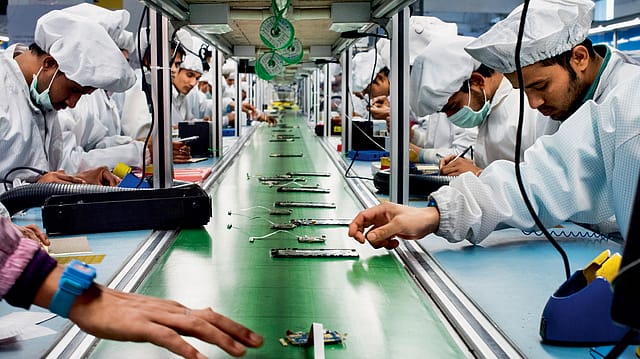Manufacturing PMI softens in June
ADVERTISEMENT

India's manufacturing activity in June fell marginally from 58.7 in May to 57.8 in June, staying above the neutral level of 50. A reading above 50 indicates an overall increase in factory output compared to the previous month.
Indian goods producers registered a sharp increase in new work intakes during June, and one that was among the strongest seen since February 2021, according to S&P Global India Manufacturing Purchasing Managers' Index.
Surging demand for Indian goods translated into higher sales figures for manufacturers, which underpinned another robust expansion in input purchasing as firms actively procured resources to support production growth.
"June's PMI results again showed robust demand for Indian-made products, both in the domestic and international markets. Positive client interest continued to support the manufacturing industry, driving growth of output, employment, quantities of purchases and input stocks," says Pollyanna De Lima, economics associate director at S&P Global Market Intelligence.
"These positive developments instilled greater confidence into manufacturers regarding growth prospects, boding well for business investment and the labour market," Lima says.
Although the latest PMI results indicated contained input cost inflation, the survey shows a marked increase in output charges. Positive demand dynamics and greater labour costs pushed charge inflation to a 13-month high. Supported by buoyant client appetite, manufacturers lifted their selling prices in June.
December 2025
The annual Fortune 500 India list, the definitive compendium of corporate performance, is out. This year, the cumulative revenue of the Fortune 500 India companies has breached $2 trillion for the first time. Plus, find out which are the Best B-schools in India.
"Presented with buoyant demand, manufacturers seized the opportunity to adjust their pricing strategies. The latest increase in output charges reflected firms' ability to pass on higher cost burdens to customers while maintaining a competitive edge," says Lima.
Although average purchasing prices continued to increase in June, the rate of inflation was mild by historic standards and among the lowest seen over the past three years, says the PMI report. "To meet rising sales, companies ramped up production in June. The expansion in output was sharp and among the fastest over the past year-and-a-half," it says.
Goods producers sought to expand capacities by taking on additional workers in June. Employment rose at a moderate pace that was broadly similar to May.
New export orders rose solidly, though, at a slower pace than in May, the PMI survey shows.
June saw another increase in input inventories. The pace of accumulation remained marked, despite softening from May. In fact, stocks of purchases rose at one of the fastest rates seen since data collection started in March 2005.
Capacity pressures remained mild in June, with backlogs of work increasing for the eighteenth month in a row but only slightly. Strong increases in sales again led manufacturers to use their existing inventories of finished goods. Post-production stocks fell at the quickest pace in the year-to-date.
